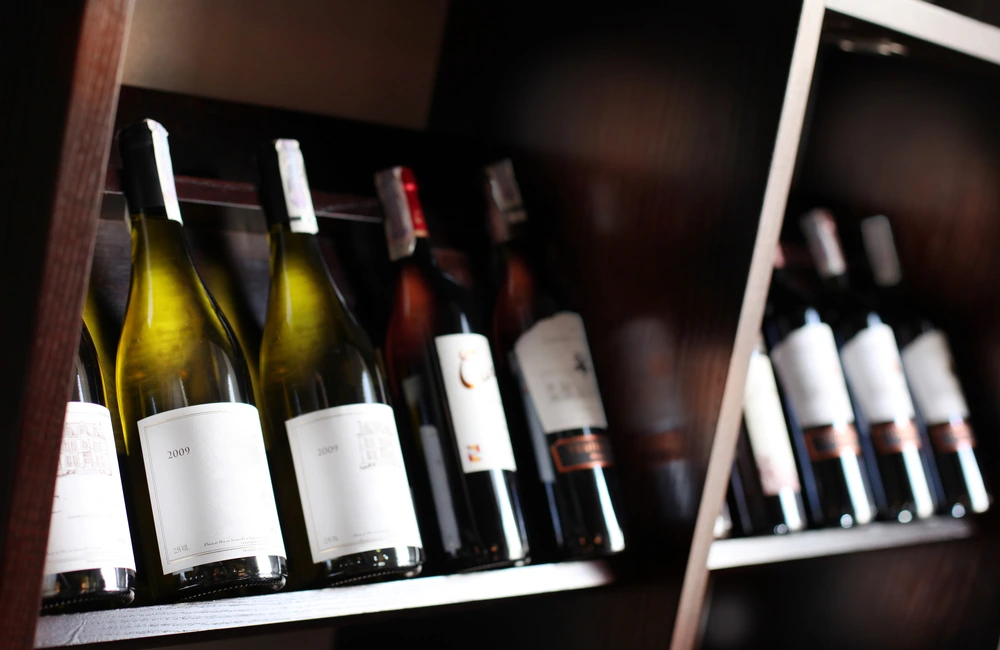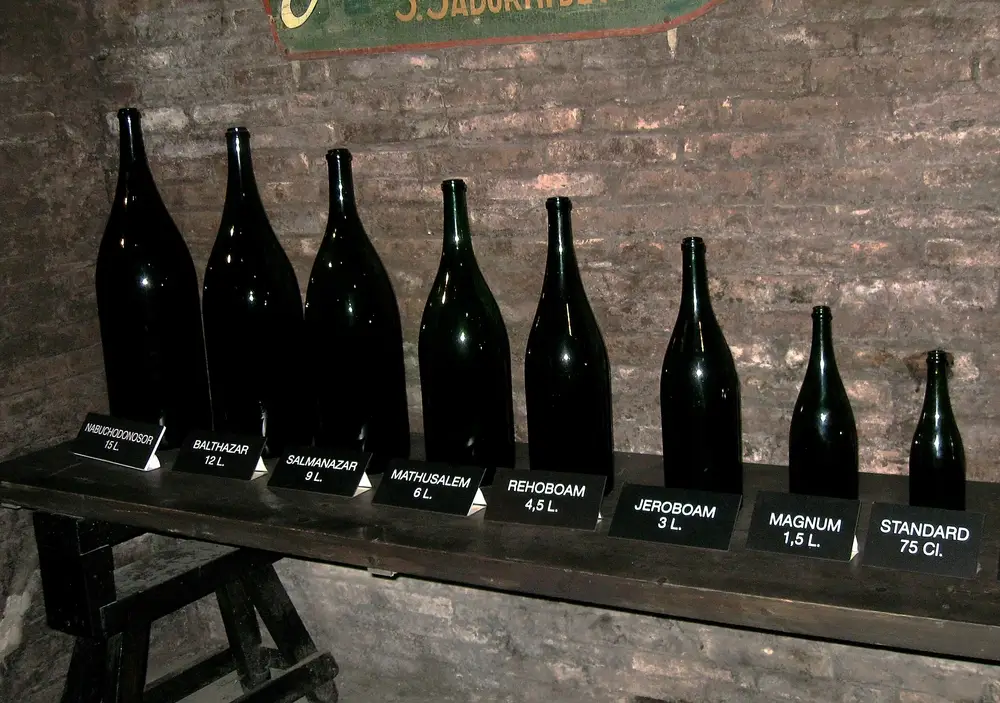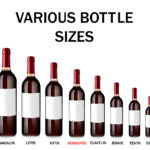Did you know that wine bottles come in many weights that could influence your storage decisions? It’s true!
The lightest wine bottle weighs under a pound, while the heaviest ways over 100 pounds!
Understanding this topic is vital for heavy-duty wine fans or wine dealers trying to market their products successfully.

What’s The Weight of a 750ml bottle of Wine?
A typical standard 750ml wine bottle weighs about 2.65 pounds.
However, wine bottles vary in weight in multiple ways, depending on their size and wine volume.
In addition, different shapes may also weigh differently, even when holding the same wine volume. In other words, this topic is a little more complex than you might think.
The Weight of a Wine Bottle
Let’s examine a few different bottle weight topics in this section, including full bottle, empty bottle, barrel, and crate weights. Doing so can help you better plan your wine orders and storage needs.
Weight of a Full Wine Bottle?

As we suggested in the introduction, full wine bottles come in many weights.
For example, your standard bottle weighs about 2.65 pounds when full. But did you know that a Salmanazar wine bottle weighs almost 32 pounds? That’s quite a difference!
Weight of an Empty Wine Bottle?
Here’s a good trick when figuring out an empty wine bottle’s weight: the liquid takes up about 60% of the bottle’s weight.
So multiply the entire weight by 0.60, subtract the result from the total, and you have an empty bottle’s weight.
Expect between 300-900 grams, with 500 grams as an average for an empty bottle of wine.
Weight of a Wine Barrel?
Wine barrels will weigh differently depending on their overall capacity.
For example, a 120-gallon barrel can hold up to 300 wine bottles.
That means it weighs about 318 pounds with the wine, though the wine barrel itself may weigh up to 20-60 pounds without the wine.
Weight of a Case of Wine?
A case of wine can typically hold about 12 standard 750ml wine bottles.
Multiplying that result would get you about 31.8 pounds or so.
The case itself is likely to weigh 5-10 pounds or so empty, so always add that weight to the additional poundage earned when storing wine bottles in it.
The Weight of Wine vs. Weight of Water: The Importance
Fun fact: water weighs more than alcohol, so drier wines will weigh less than sweeter ones.
Wines with 12% alcohol or less weigh less than water, which can influence things like storage and shipping.
For example, sugar weighs more than water, meaning that sweeter wines may cause more strain on your storage shelves than drier wines. Keep this fact in mind when considering the weight of bottles for your storage needs.
Related: How many grapes are in a bottle of wine?
The Importance of The Weight of a Wine Bottle
Winemakers choose different bottle weights for varying reasons. The weight is more important than you might think and can indicate a variety of things, including:
Quality

Wine fans know that heavier wine bottles typically indicate higher quality wine.
Some people may even buy their wine based on the bottle’s weight! So when choosing a wine bottle for your home or commercial needs, keep this in mind.
Marketing
Winemakers may market their bottles as weighing less to attract more potential buyers or casual fans.
Conversely, luxury winemakers may focus more on a wine bottle’s heavier size and weight to showcase the wine’s quality and taste, and storage capabilities.
Packaging
A heavier wine bottle is going to cost more to make and may be harder to ship and handle.
By contrast, smaller bottles may have more compact packaging but break more easily. These things all influence why companies choose different wine bottle weights.
The Different Weights and Sizes of Wine Bottles
Wine bottles come in many sizes and weights.
Let’s take a look at these different bottles, from lightest to heaviest, to give you an idea of which is suitable for you and your wine-drinking experiences:
- Piccolo: Also called a split bottle, this bottle weighs around 0.66 pounds and is by far the lightest wine bottle on the market. You typically see this bottle popularly used with sparkling wines and other similar wine options.
- Half: A half or demi bottle weighs around 1.32 pounds and is typically a good size for about two people. You commonly find this bottle in wine stores advertised as single-serving or a similar serving name, though it holds about 2.5 wine glasses.
- Half-Liter: Otherwise known as a Jennie bottle, this bottle is pretty unusual and is mainly used with sweet wines like Tokaj. It usually weighs around 1.76 pounds and can hold about three glasses of wine, which should be suitable for small get-together events.
- Standard: This wine bottle is the type you see most often on the market: it’s your standard 750ml option. It weighs around 2.65 pounds and is a good choice when you are serving for a larger party or plan on enjoying one wine glass a day during a week.
- Liter: This upgrade on the standard wine bottle has become popular with premium European wines because it provides you with two more glasses than a standard bottle. It weighs around 3.53 pounds, which is where you may start noticing an actual weight difference.
- Magnum: As the name suggests, this wine bottle is a beast and is equivalent to two standard wine bottles. It’s a great choice when you’re serving for a very large party or when storing reds for a long time. It weighs 4.65 pounds, which means you could get a good workout lifting it.
- Double-Magnum: If you thought you couldn’t get more significant than the magnum, you were a mistake. The double magnum, or Jeroboam, holds an equivalent of four standard bottles and weighs about 10.6 pounds. As you can imagine, that’s a lot of wine to get through, making it suitable for storage.
- Rehoboam: The fantastic thing about the double magnum is that it’s not even the most extensive wine bottle on the market! This bottle holds six standard bottles of wine and is typically used by Champagne brewers when holding sparkling wine. In addition, it weighs about 16 pounds, giving you a real workout when lifting it!
- Methuselah: Otherwise known as the Imperial, this wine bottle is truly the stuff of legend. Named after the oldest man in the Bible, it is a practical option for storing up to eight standard bottles of wine for lengthy periods. It weighs a staggering 21.2 pounds. Somehow, we’re not done yet!
- Salmanazar: An almost ridiculously large bottle of wine, the Salmanazar weighs 31.8 pounds and can hold 12 standard bottles of wine. This bottle is not too heavy for most people to pick up by themselves but is a little awkward. As a result, you may need help with it.
- Balthazar: At 42.4 pounds, Balthazar is equivalent to 16 standard wine bottles is truly a beast. It’s a good option for long-term storage or as a mid-weight wine bottle for less sturdy wine storage shelves or for general use in your kitchen.
- Nebuchadnezzar: Named after a popular king in ancient Babylon, this wine bottle weighs about 53 pounds. At this point, we’re getting past everyday use and into more long-term storage options. You typically find this option used more for wine dealers.
- Melchior: Do you want a wine bottle that can hold 24 standard bottles or two cases of wine? Try this bottle, which weighs about 63.6 pounds. Again, we’re getting well past the point of reasonable, everyday use with this bottle.
- Solomon: Named after the wisest king from the Bible, this bottle holds 26 standard bottles or 130 glasses of wine and weighs 70 pounds when filled. You probably need to store this bottle on the ground in your cellar.
- Sovereign: Created to celebrate the Sovereign of Seas cruise liner and still used today for many wine storage needs, this bottle weighs a whopping 92.75. At the time, it was the largest wine bottle in the world.
- Primat: Also known as the Goliath, this wine bottle is just over 95.4 pounds and is a minor upgrade on the Sovereign. Fun fact: it can hold three cases of wine in one bottle, making it a good option for heavy-drinking wine fans.
- Melchizedek: The King of Wine Bottles weighs 106 pounds and holds 200 glasses or 40 standard wine bottles. You can’t get any bigger than this: though don’t be surprised if a wine manufacturer does make a bigger bottle at some point.
Related: Checkout all these bottle sizes and how many ounces each carry.
You can typically find these larger bottles from various manufacturers.
Some wine dealers may even ship them directly to your home when ordered. However, understand that you’re going to pay a bit more for shipping and handling: sometimes as much as double, depending on the wine you purchase.
Pros and Cons to Storing Wine in Different Bottle Sizes
When choosing your wine bottle sizes and weights, it is essential to know more about how they can benefit you.
Small, medium, and big bottles all have significant benefits and some downsides that must be considered before purchasing.
Here’s a breakdown of why you might want to buy various bottle sizes:
- Big Bottles Provide Better Aging: Larger wine bottles can age better than smaller ones because there’s less oxygen exposure. The sheer size of the bottle helps protect most of the wine from oxygen and helps it stay fresh and clear longer than smaller bottles. Upgrade to bigger bottles when storing a lot of wine. Obviously, larger bottles become pretty awkward to handle as you upgrade.
- Smaller Bottles Serve Better: The main advantage of smaller bottles is that they simply serve better than bigger bottles. Trying to haul a 30+ pound wine bottle out of your basement to your kitchen is absurd and is usually not worth the hassle. Instead, you can store smaller bottles and serve them to your guests in this way. Note that smaller bottles do tend to age more poorly.
- Medium Bottles Provide a Better Balance: Medium bottles may provide an outstanding balance between storage and serving. However, the main disadvantage of these bottles is that they are “neither fish nor fowl.” What we mean is that they store better than small bottles but not as well as bigger bottles and serve better than large bottles but not smaller options. In other words, they do nothing exceptionally well.
The trick here is to know what you want and to buy wine bottles that suit your needs.
For example, do you plan on storing large volumes of wine over extended periods to age it perfectly? It would help if you considered medium or large bottles that age better than smaller ones.
However, smaller bottles should work well if you’re more of a short-term wine fan or someone who may drink no more than a bottle per week.
In Summary
Is it worth investing in multiple bottle sizes when getting into viticulture? That all depends on how seriously you plan on getting with your wine consumption.
Serious fans who plan on drinking many bottles through the year may want more prominent and heavier bottles for storage and smaller bottles for easier serving.
Please pay attention to your storage room’s weight capacities, as well, to make sure you don’t overwhelm it.
- Shrimp Cocktail (and More) Wine Pairing Guide - 09/06/2022
- What Wine Serving Sizes Look Like: Standard Size and More - 08/06/2022
- How Much Sugar is in Wine: Glass and Bottle Sugar Content - 08/06/2022






